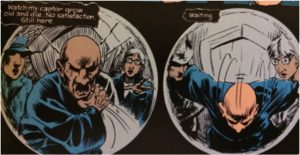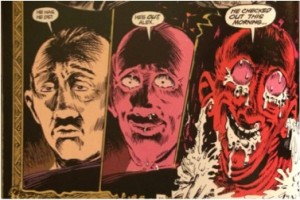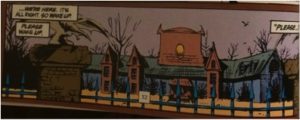Neil Gaiman’s The Sandman, which ran from 1988 – 1996, totaling at 75 regular issues, is arguably the definitive title that put Vertigo on the map. Originally published as a DC title, much like Alan Moore’s The Saga of the Swamp Thing, The Sandman moved to Vertigo with its forty-seventh issue. As I dialed back to November 29th, 1988, the day The Sandman #1 was released, to revisit and dissect the first issue and all of its components, I was amazed by how the trademark literary style, British sensibility, adult content, and form-breaking that would come to define Vertigo’s ethos was present even in the first issue.
TITLE
The Sandman No. 1
“The Sleep of the Just”
“The Sleep of the Just” is also an Elvis Costello song, but Gaiman is very likely also referencing the Jean Racine quote: “Elle s’endormit du sommeil des justes.” She slept the sleep of the just. This line shows up in the actual issue, referring to Wesley Dodds, DC’s first Sandman:
“Wesley Dodds’s nightmares have stopped since he started going out at night. He puts evil people to sleep with gas, then sprinkles sand on them, leaves them for the police to find in the morning… The idea came to him in his sleep. He doesn’t dream about the man in the strange helmet anymore. No more burning eyes. Eveyrhting’s all right. Wesley Dodds sleeps the sleep of the just.”
This title also seems to taunt the two antagonists (of sort) of the issue, Mr. Burgess and his son Alex, the former who dies disappointed and the latter whose sleep becomes cursed. But more on them later.
HISTORY
The Sandman was originally published in 1939, when it focused on the aforementioned Wesley Dodds. Dodds was a more standard superhero than Dream/Morpheus, the lead of Gaiman’s The Sandman series. Before Gaiman would successfully pitch the story that would become the definitive Sandman epic, other characters such as Garrett Sanford and Hector Hall also held the mantle.
Though Gaiman would explore some of the DC Universe, even using some superheroes, as well as characters from Alan Moore’s Swamp Thing run, he was given free reign to create an entirely new Sandman mythology from whole cloth. It’s clear in the first issue that all we’re getting is a passing – yet poignant – reference to Dodds, and then moving on. And that’s just what the book does.
FIRSTS AND LASTS
FIRST LINE:
“Wake up, sir. We’re here.”
LAST LINE:
“Please wake up. Please…”
CREATIVE TEAM
Written by Neil Gaiman. Gaiman would go on to write 75 regular issues of The Sandman, as well as special issues, spinoffs, and even a new series called Overture that is currently being released.
Art by Sam Kieth and Mike Dringenberg. Colors by Robbie Busch. Letters by Todd Klein. The Sandman would see a rotating list of artists with varying styles, but Kieth, Dringenberg, Busch, and Klein’s work on the first issue was murky, chaotic, and horrific, evoking both (again) the scarier parts of Moore’s Swamp Thing, showing that horror isn’t only present in the gory scenes, but it lurks in the panel borders, in mundane shadows, and in the darkness and light of people’s eyes.
Cover by Dave McKean. Dave McKean started with The Sandman with this first issue and, like Gaiman, would see it through to the end. His fascinating, beautiful, and often troubling covers were multi-media, often a mix of painting and photography that created some of the most iconic and distinctive covers ever published.
PLOT
A magus named Mr. Burgess attempts to capture Death to divine the reaper’s mystical knowledge and conquer his mortality, but mistaken imprisons Dream. Burgess keeps Dream locked away, hoping to somehow wait him out, but Burgess grows old and dies, passing the burden of the prisoner to his son, Alex. Alex, both in awe of his father and furious that he must live in his shadow, refuses to release Dream, half frightened of what Dream may do to him, half of disobeying his dead father. While Dream is imprisoned, many people suffer from sleeping ailments, and Gaiman expertly weaves the stories of these poor souls into his narrative.
It’s exceptionally well-written, both as literary horror and as a comic pushing at the perceived boundaries of its medium, but it isn’t mind-blowing until the end. When Morpheus escapes and curses his captor’s son with eternal waking, the gravity of the horror sinks in. Alex Burgess will forever live in the moment where he wakes up, and then reality twists to show he is still in a dream. While his actions were despicable, the surreal horror of this situation taps into the base fear of nightmares, but it’s complicated and made brilliant by the fact that not only does this terrify us, the readers… but we also kind of cheer for it. Gaiman’s writing has us siding with a ethereal entity who we don’t yet know much about – and still won’t know much about for issues to come – as he takes out his revenge on a human. It’s a painfully clever inversion of the perspective you’d expect to follow in a horror comic, which Gaiman continues to do for the 70+ issues that follow this first installment.
COLLECTED
The Sandman #1 has been collected in:
– The Sandman Volume One: Preludes and Nocturnes. This trade paperback, perhaps the most accessible collection including this classic first issue, collects The Sandman #1-8.
– The Annotated Sandman Volume One. This version, as you probably gathered, includes Gaiman’s notes on the first twenty issues of the series.
– The Sandman Omnibus. These are two huge volumes, sold together, encompassing the entire series.
– The Absolute Sandman Volume One. Much like the Annotated version, this is an oversized hardcover collecting the first twenty issues. However, like all of DC’s Absolute Editions, this receives the royal treatment. High quality paper and binding, a slipcase, and even some tweaks to the interiors, this is for the die-hard Sandman fans.
PAT SHAND is a writer best known for his work on Robyn Hood, Charmed: Season Ten, and Angel. When he was a child, he dreamt that a clown with needles for teeth was doing his father’s taxes in the living room. Ever since then, dreams have been a touchy subject.





Comments are closed.